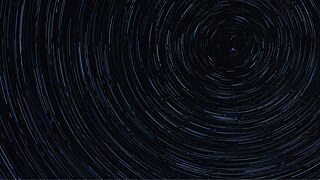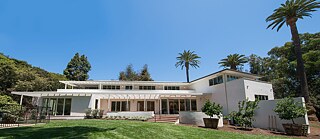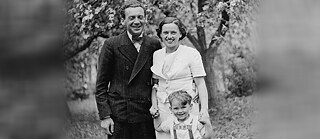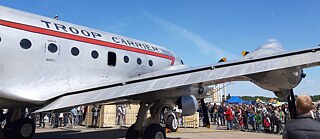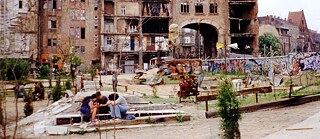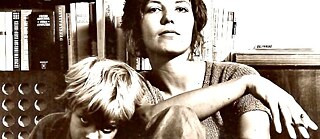German artists in Southern California
Villa Aurora and Thomas Mann House in Los Angeles
During the Nazi regime, many German artists and intellectuals found refuge in Southern California. In Los Angeles, the homes of authors Lion Feuchtwanger and Thomas Mann still inspire transatlantic art fellows today.
Listen to this episode: Apple Music | Spotify | Download
This episode is by Kerstin Zilm. Kerstin came to Los Angeles in 2003 with Germany’s public broadcasting network ARD. When the assignment ended, she decided to stay in California, where she created her own production company and became an independent journalist. In this podcast, Kerstin talks to the fellows and the program director of the Thomas Mann House as well as the director of Villa Aurora. We also hear from Thomas Mann’s grandson Frido Mann. In addition to this episode, Kerstin produced the episodes “A Day With John Lennon” and “Klinsmann in California.” The featured photo shows the Thomas Mann House in the Pacific Palisades.
Transcript
Kerstin Zilm: During the Nazi Regime, German artists, scientists, and other intellectuals found refuge in Southern California. Lion Feuchtwanger and Thomas Mann were two of the more prominent “exiles in paradise.” Their new surroundings reminded them of the Mediterranean while they were constantly thinking about the country, friends, and family they had to leave behind. Exile, transatlantic relationships, and debates about pressing global issues — those themes fill Feuchtwanger’s and Mann’s former homes again today. Take a trip to the Villa Aurora and the Thomas Mann House in Pacific Palisades.
Margit Kleinman: Feuchtwanger himself was then under the Vichy government interned in the South of France for about six months, in Les Milles, an internment camp. And she, Marta, was only interned for a couple of weeks in a women’s camp.
Kerstin Zilm: Margit Kleinman, director of the Villa Aurora, tells the story about how Lion and Marta Feuchtwanger came to Los Angeles. She leads a spontaneous tour through the maze of rooms, staircases, and hallways, across creaky wooden floors, past black and white pictures, drawings, and busts. About 15 visitors follow her through the last home that the Feuchtwangers created for themselves. Lion died in California in 1958, his wife almost thirty years later, in 1987. Lion Feuchtwanger had been a critic of Adolf Hitler since the 1920s. The Nazis took away his German citizenship and publicly burned his books. The couple first fled to Southern France, which proved to not be safe.
Margit Kleinman: ... and finally, with the help of — among other people — Eleanor Roosevelt and American diplomats they managed to smuggle Feuchtwanger out of the internment camp in women’s clothes. And then they immediately went on foot over the Pyrenees mountains into Spain. The same group was joined by Heinrich and Thomas Mann. It was a very dangerous, very perilous trip. When they were in Spain they went to Lissabon and from Lissabon they took the ship to New York.
Kerstin Zilm: The Feuchtwangers soon joined an already large group of exiles in Southern California. Marta found the Villa Aurora at 520 Paseo Miramar in the hills of Pacific Palisades, overlooking Santa Monica bay with breathtaking views of the Pacific Ocean. She loved the Spanish style house among eucalyptus and palm trees with towering white walls, red roof tiles, balconies and the big yard she could turn into a blooming garden. Nobody had lived in the house for several years, so it was in bad shape when the Feuchtwangers arrived. But the newcomers felt it was perfect for creating a writer’s home here, with enough space to entertain friends and colleagues. It was exactly what Marta had been looking for.
Margit Kleinman: It was affordable. It cost 9,000 dollars. Then it was about three years of salary for a school teacher. They could afford it. They got an advance for Feuchtwanger’s next novel. And so they moved in. They had to do a lot of repairs. Some neighbors helped. It is said that they spent the first couple of days or nights in the garden because they had to clean up, windows were broken and all that stuff.
Kerstin Zilm: Marta brought furniture from surplus and secondhand stores in Los Angeles to the villa. Soon fellow exiles and newfound Hollywood friends became regulars in their salon and garden, villa director Kleinman explains, among them Bertolt Brecht and Hanns Eisler, Charlie Chaplin and Arnold Schönberg, Franz and Alma Werfel, Thomas and Heinrich Mann.
Margit Kleinman: Of course it was the common language and the common fate that brought them together but also of course the interest in each other and each other’s works. In this house, you can say, the who is who of intellectual and artistic European exile community found their hub.
Kerstin Zilm: As a symbol of his determination to build a new home in exile, Lion Feuchtwanger followed his greatest passion other than writing and started his third library. The first one in Berlin burned down in 1933. He had to leave the second one behind in Southern France. When Feuchtwanger died, he had a collection of 30,000 books, 8,000 of which are now in the University of Southern California’s special collections department. 22,000 are still in bookcases at the Villa Aurora.
[APPLAUSE]
Margit Kleinman: Welcome to Villa Aurora, and thank you for making the schlepp out of LA or wherever you come from.
Kerstin Zilm: Margit Kleinman now welcomes the latest group of fellows, who have come to stay three months in the Villa. The house became an artists residence more than twenty years ago. When Marta Feuchtwanger died, it looked like the house might be put on the market and torn down. A group of artists, diplomats, politicians, and journalists stepped up to buy the property. The villa was renovated, saved from sliding down the hill, and the foundation was strengthened according to the earthquake code. In 1995, the first fellows arrived for a newly created program funded by the German government. Since then, more than 350 artists have enjoyed the opportunity to get away from their routines at home, to be inspired by beautiful surroundings, the history of the place, and by the city of Los Angeles. For fellow Stef Heidhues it is not her first time in California. The visual artist is grateful for the chance to explore Los Angeles some more without any pressure to show a specific result at the end of her stay at the Villa.
Stef Heidhues: I think, first of all, it was just a city I really wanted to know. I know New York. And with my topic, which is basically “blank space” it turned out to be a good space for me to find footage and all the signs and everything is made for people driving with a car. It kicked off a lot when I was here the first time, so I needed to come again.
[RECORDED SOUNDS]
Kerstin Zilm: Hanno Leichtmann, a composer and sound artist, plays examples of his art from the computer. He is staying in Lion Feuchtwanger’s former bedroom for three months, but during his stay he mostly composes and experiments in the Villa’s music studio. The small room in the back of the house used to be Marta Feuchtwanger’s favorite spot, where she had her Sherry and welcomed visitors. Leichtmann likes to explore the city. Even traffic in Los Angeles has become an inspiration for the artist.
Hanno Leichtmann: I drive around a lot. Hollywood. Downtown maybe. Santa Monica and Venice. It doesn’t matter so much. I just enjoy listening to music in the car and drive around and then go for a coffee or whatever it is.
Kerstin Zilm: The visitors have moved from the living room to the garage. There, Sabine Reinfeld performs an excerpt from her multimedia act, Frau Berlin Framed. She moves slowly in high-heeled boots and a yellow-pink neoprene suit. The artist is observed by cameras and surrounded by recorded images that are projected on the walls. She steps into, out of, and around a white hanging picture frame. Reinfeld creates an intriguing and disturbing atmosphere while the visitors who are cramped into the small space almost touch her. She was born in the former East Germany and grew up with a lot of stereotypes regarding the United States, Reinfeld says, most of them the results of watching Hollywood movies. Some of those stereotypes were confirmed during her stay at the Villa Aurora, other aspects of California came as a surprise.
Sabine Reinfeld: Here you have all this nature, this ocean, all these palm trees, on one side you have all these clichés and on the other hand you have very authentic places. And: to see that the city is built for the cars, and to have always this frame from the window to the city. And then I work with frames and with framed of framed of framed pictures. It makes sense for me to work here.
Kerstin Zilm: Hanno Leichtmann does not think about the Feuchtwangers a lot while staying in their former home, he says. On the contrary, the women feel Marta’s spirit and vibes in the house. Sometimes, Stef says, she thinks of her at night, when two deer step onto the grass in the moonlight, feeding on dates from a tree in front of her room. Sabine can’t help but imagine what it must have meant for the exiles to live in this paradise, while friends were facing war, persecution, and death in their home country. She also thinks a lot about what it means to lose your language and cultural references when you are forced to leave home.
Sabine Reinfeld: To have this beautiful place, but on the other hand you have all this old culture and all these strong things not here. You can be very light here in California, but actually this lightness can also destroy things, because it is such a golden light and so beautiful and so deep.
❡
Kerstin Zilm: From the Villa Aurora it is only a fifteen-minute drive on Sunset Boulevard to another former hub of European exiles in Los Angeles: 1550 San Remo Drive. This is the former home of world-famous writer and Nobel laureate Thomas Mann. He lived here with his family from 1942 to 1952.
[MUSIC PLAYING IN THE BACKGROUND]
Kerstin Zilm: In June 2018, black limousines parked on the winding streets surrounding the house announce important visitors. The two-story building is hidden from the streets among eucalyptus and palm trees, oleander bushes and bougainvilleas. The last weeks have been busy and noisy. The house has just been renovated. Now visitors from the United States and Europe mingle in the yard. Students and professors, artists and intellectuals, neighbors, politicians, and journalists are waiting for Frank-Walter Steinmeier, Germany’s federal president. He has travelled to Los Angeles to officially open the property for its new mission. While a DJ entertains the crowd outside, inside Thomas Mann’s grandson Frido Mann shares stories about the place. In a white suit and with animated gestures he talks about the times he spent here as a kid. He visited the place a lot from the age of two until he was nine years old. Frido even went to school in Pacific Palisades before the Manns left for Switzerland.
Frido Mann: [IN GERMAN] Jeden Abend saß man da aufm ... am ... Sofa. Hier war der Musikplattenschrank, da wurde immer Musik gespielt. Hier stand ein Flügel, der jetzt bei mir in München ist.
Kerstin Zilm: Frido Mann points from the sofa to the fireplace and the porch where, he says, the grandfather, his family and friends listened to records and live piano music, sometimes even played by Thomas Mann himself. Frido remembers reciting poems in the living room. Most of all, he recalls how the house was filled with passionate discussions about current events and political developments in Europe and the United States. The groups gathered here were also regulars at the Feuchtwanger Villa. The conversations often spilled out into the yard. When the weather was good, Frido says, everybody just wanted to sit outside on the porch in the sun.
Frido Mann: [IN GERMAN] Aber meistens saß man dann doch wenn es sonnig war im Sommer, auf dieser porch, es hieß immer die porch, da war man da draußen.
Kerstin Zilm: The Mediterranean climate was one reason for the Mann family to stay in California. Like the Feuchtwangers, they loved the views to the mountains and the ocean. But most of all they felt the freedom to express themselves that had been destroyed at home in Nazi Germany. Thomas Mann enthusiastically supported the USA’s form of democracy. In June 1944 he became a U.S. citizen. Once the family decided to stay, they wanted to build their own home. They bought the property and hired architect Julius Ralph Davidson, who was also a German-speaking immigrant. He was instructed to create a family home with separate chambers for Thomas Mann, where he could write, relax and focus in his study without being distracted. It took a while until the house was ready for them to move in, but once the family had settled in, they loved it. Thomas Mann called it “Das Haus zu den sieben Palmen,” “The House of the Seven Palm Trees.” At his desk surrounded by bookcases he looked through big windows out into the yard. Here he wrote essays, speeches, lectures, and novels as well as his famous letters to the German people, broadcast by the BBC:
Thomas Mann: [IN GERMAN] Deutsche Hörer! Dem, der heute wieder zu euch spricht, war es vergönnt, im Lauf seines nun schon langen Lebens für das geistige Ansehen Deutschlands einiges zu tun. Ich bin dankbar dafür.
Kerstin Zilm: Mann wrote more than 50 of those audio letters. They were five to eight minutes long, pointed dissections of the political situation and the war in Europe. He called on the Germans to stand up for moral values and to acknowledge the unspeakable acts committed by the Nazi regime. Mann foresaw a dark future for Germany, which — he was convinced — would be overwhelmed by growing hatred once the war machinery broke down.
Thomas Mann: [IN GERMAN] Das Unaussprechliche, das geschehen ist und geschieht, wisst Ihr, wollt es aber lieber nicht wissen, aus berechtigtem Grauen vor dem ebenfalls Unaussprechlichen: dem ins Riesenhafte heranwachsenden Hass, der eines Tages, wenn Eure Volks- und Maschinenkraft erlahmt, über Euren Köpfen zusammenschlagen muss.
Kerstin Zilm: The California paradise showed its shadows shortly after the end of war. The United States, the country that Thomas Mann saw as an example of a thriving democracy, changed. During the McCarthy era the writer found himself, friends, critical minds, and fellow artists under scrutiny again. The freedom of speech and tolerance he always had admired gave way to suspicions, accusations, and surveillance. The family left for Switzerland in 1952 and sold the house. It came on the market again in 2016. “Five bedrooms, four baths, a four-car garage, great mountain and ocean views,” the realtors raved in their ad. They did not mention the famous previous owner. Instead, they highlighted the opportunity to build a new, more modern and bigger house at a desirable location. Again, the German government stepped in and bought the property for 15 million dollars in order to create a space for transatlantic discussions. Like the Villa Aurora, the Thomas Mann House will host fellows, but instead of inviting mostly young artists to work undisturbed by specific requirements to produce their own works, this house will welcome established scholars, artists, and researchers who are expected to ignite discussions in the spirit of its former owner. Program director Nikolai Blaumer explains:
Nikolai Blaumer: Questions of social justice, of equality, of equal rights for all the members of a democratic society, these were values that were crucial for him, especially during the time of German fascism. I think these universal liberal values are also something that are in danger today and are part of our mission and our self-understanding as the Thomas Mann House. We see our task in fostering these kind of values in our societies on both shores of the Atlantic.
Kerstin Zilm: In order to turn the former family home into a modern residence for up to five fellows, the house had to be gutted. New walls, air conditioning, and heating were installed. At the opening, finishing touches are still missing. Cables and wires are poking out of some walls. The scent of plywood and fresh paint is in the air. Bushes have been planted temporarily. A red carpet connects the gate and the porch. It also hides some unfinished repair work on the driveway. Those details cannot diminish President Frank-Walter Steinmeier’s enthusiasm for the new venue established to foster transatlantic relationships. He was a driving force behind the purchase of the house in his former role as Germany’s Foreign Minister. When Steinmeier arrives, he welcomes everybody to what he calls “a wonderful moment for the friendship between Germany and the United States in turbulent times.” He does not need to mention the name of the current U.S. president, who questions longstanding alliances.
Frank-Walter Steinmeier: Tonight, ladies and gentlemen, the attention of our transatlantic community is on a ... different White House. Indeed, [LAUGHS] ... indeed this house was not only a family home, not only a place of thinking and writing, a center of Weimar on the Pacific, a hub of literature, music, film, and art. No, this was a White House, and Thomas Mann’s study was in many ways the oval office of the émigré opposition to Hitler’s reign of terror in Berlin.
Kerstin Zilm: Among the visitors listening in the yard are the first fellows: actor and writer Burghart Klaußner, Thomas-Mann-researcher Heinrich Detering, and sociologist Jutta Allmendinger. President Steinmeier says their mission is important. They are here to help restore democratic traditions, passionate and open-minded debates between the United States and Germany:
Frank-Walter Steinmeier: The struggle for democracy, the struggle for a free and open society is what will continue to connect us. The United States and Germany. To me, that is the essence to which this historic place and these new fellowships shall be dedicated: a transformation of the intellectual climate, a new spirit in which democracy will thrive.
❡
Margit Kleinman: It’s a pleasure once again to have our own Michael Mortilla now for the fourth season.
Kerstin Zilm: Back at the Villa Aurora a few weeks later, director Margit Kleinman welcomes another group of visitors. They have come for the Silent Salon, a summer series of afternoon picnics in the garden followed by evenings of silent movies. Those are accompanied live by pianist and composer Michael Mortilla. An organ was part of the original design for the villa and was restored in 2010. This season of Silent Salons has been dedicated to Ernst Lubitsch movies. As a special treat Lubitsch’s daughter Nicola introduces her father’s work.
Nicola Lubitsch: I want to thank you for hosting this. It is really an honor. What a setting here to have this, it’s just magical ...
Kerstin Zilm: Visitors sit on folding chairs in the salon, where exiled intellectuals used to meet. Mild air flows through the open balcony doors into the room. The sun sets over the Pacific. Santa Monica Bay, the Ferris wheel, and the roller coaster on the pier turn into a necklace of twinkling lights. This night’s movie is a lesser-known Ernst Lubitsch film: Die Bergkatze, released in 1921. One year later, the director left Germany for Hollywood and established a reputation for producing sophisticated and stylish comedies. He was nominated for the Academy Award for Best Director three times and in 1946 received an Honorary Academy Award. Die Bergkatze with Pola Negri in the title role is a farce and romantic comedy. Lubitsch’s daughter Nicola had to do some research to find out that there was more to the crazy love story.
Nicola Lubitsch: I become to realize that my father actually had a very anti-war and very political view of the world, not to mention his love of women and strong women, which is very evident in this film. But this is really a protest against militarism coming after the war in Germany. I think perhaps today, it’s very relevant for us and really speaks to us, particularly important these days.
[ORGAN MUSIC]
Kerstin Zilm: From two small chambers at the salon’s front and back walls organ music booms through the room. The black-and-white film begins: sleepy soldiers fall out of their bunk beds when an officer in uniform and with a thick mustache screams at them. Organist Michael Mortilla improvises according to the actions on the screen. He has been playing the Villa organ regularly now for four years. Mortilla loves this setting. He likes to come early for the picnic and uses the time to browse the library for rare books about music, composers, and silent movies. The atmosphere and energy in the salon, he says, are special.
Michael Mortilla: The organ is almost haunted, ‘cause I’ll be playing, and I’ll hear extra notes. And it’s ... and it’s probably because I’m a little sloppy and I’m hitting two notes ... but every once in a while I hear something, it’s like, I didn’t play that note and I think: is this place haunted or what? But, ehm, it’s probably not. But even if it’s just a vehicle for my imagination, it works, and it’s way cheaper than drugs. [LAUGHS]
Kerstin Zilm: Director Margit Kleinman laughs about these stories of the haunted Villa. She often hears them from visitors and fellows, but still does not believe in ghosts spooking around in the place. Kleinman met Marta Feuchtwanger once in 1987, shortly before she died.
Margit Kleinman: Well, she was this figure, very sure of herself, very cultured, very awake, alert. She knew a lot and she had lived through a lot, so that showed.
Kerstin Zilm: The Villa also has a program that is designed specifically for artists who have lived through a lot and need a place of refuge. Feuchtwanger fellows, as they are called, have included the Syrian editor of a feminist magazine, a Cambodian blogger, journalists and writers from Tunisia and Zimbabwe. This year’s fellow was a Syrian-Turkish journalist covering political conflicts in the region. Onur Burcak Belli has returned to Turkey, but Maria Schrader, who stayed with her at the Villa, recalls a moment the shared that she will probably not forget. The German actress, writer, and director worked on a new screenplay at Lion Feuchtwanger’s former desk overlooking Santa Monica Bay. She often met with Burcak Belli in the garden.
Maria Schrader: [IN GERMAN] Ich erinnere einen Abend, wo sie die Nachricht bekam, dass ein befreundeter Journalist gerade verhaftet wurde.
Kerstin Zilm: One evening, she says, the journalist received the message that a friend of hers had been arrested for his work as journalist. Burcak Belli looked towards the ocean and realized the absurdity of the moment. The view could not have been more beautiful while on the other side of the world these awful things were happening. Schrader recalls thinking about the many people who have been standing in this garden — probably with the exact same feelings.
Maria Schrader: [IN GERMAN] … und dann dachte ich: wie viele Leute wahrscheinlich in diesem Garten mit genau den gleichen Gefühlen saßen.
❡
Kerstin Zilm: Meanwhile, the Thomas Mann House fellows have gone to work. Heinrich Detering, who heads the Thomas Mann Research Center in Germany, is visiting the First Unitarian Church of Los Angeles. In his jeans and white shirt, his grey hair cropped short, he looks more like a cheerful school teacher than an award-winning German professor. From the podium he talks about the relationship of Thomas Mann with this church.
Heinrich Detering: Although Thomas Mann’s relationship to religion has been thoroughly investigated, his late and lasting embrace of the Unitarian Church has been ignored for a long time.
Kerstin Zilm: The church in the center of Los Angeles was founded in 1877 and still today is one of the most progressive churches in the city. Its members fight for immigrant rights, social and racial justice. It was this engagement, Detering says, that attracted Thomas Mann to the church. In this building, he gave the only sermon of his life.
Heinrich Detering: He felt connected to the Unitarians personally and intellectually. Only a few months before his death in Kilchberg in Switzerland, Thomas Mann wrote to the Unitarian minister in Los Angeles whom he called his friend: “The spirit of your church, it is this spirit that I find attractive since I got to know it.”
Kerstin Zilm: A debate between Detering, program director Nikolai Blaumer, community activists, and immigration advocates follows the lecture. It is the first step to fulfilling the Thomas Mann House’s mission: igniting debates beyond the walls of the former home. In Pacific Palisades, Thomas Mann’s study has become Detering’s work place. The professor writes at the same spot the writer did. He is surrounded by the same books as Mann was. When he looks up from his work he has Mann’s view out into the yard. Detering feels at ease in this place.
Heinrich Detering: This is obviously a very overwhelming presence, to live in the house that Thomas Mann and his family and friends lived and worked in, and to even sit in Thomas Mann’s study. I found myself surprisingly relaxed and content with being here. I haven’t been so relaxed and concentrated and in such a good mood for my own work and writing as I am here for a long time.
[CONSTRUCTION NOISE]
Kerstin Zilm: While Detering relaxes in the study, sociologist Jutta Allmendinger has a lively conversation with construction workers and landscapers, who are still busy in the kitchen, baths, bedrooms, and yard. The fellows had no hot water until a few days ago. The air conditioning still does not work. Allmendinger, the president of WZB, the Social Science center of Berlin, seems to find that more amusing than disturbing.
Jutta Allmendinger: Then I got friends with all the workers and I learned about their living conditions, their working conditions, how much they earn, that they really have to work seven days a week. I learned that they’re all Latinos and that their bosses are all Americans.
Kerstin Zilm: These encounters and conversations led Allmendinger to a new project: She wants to research the living conditions of the working homeless, people who sometimes work several jobs and still cannot afford the rent in this city. Until then she does her research in Thomas Mann’s former bedroom and feels some pressure to live up to the former owner’s habits.
Jutta Allmendinger: I think that I have to live according to his discipline and according to his way of structuring his day. So, I really get up early and I’m really usually working until one. And then I have a break and then I socialize with people and look for my neighbors and the workers, which I don’t do in Germany at all. The only explanation I have is a ghost of Thomas Mann being still in this house.
Kerstin Zilm: The past is present in the Thomas Mann House and in the Villa Aurora. Their missions connect the German exiles who found a refuge in Southern California, their stories and their art, their thoughts and their beliefs with the here and now. No matter who comes to stay in these buildings a few months at a time, they will all contemplate what it means to be separated from your home, your language and your culture. They will imagine what it means to stand up for your values and raise your voice for democracy. They will stand among palm trees, gaze towards the ocean and imagine how many people are looking for refuge today. Then they will create their art, write essays, books and speeches, and come home with a new perspective on what it means to live in exile in paradise. This is Kerstin Zilm reporting from Los Angeles.

